+検索条件
-Structure paper
| タイトル | Cryo-EM structures of complex I from mouse heart mitochondria in two biochemically defined states. |
|---|---|
| ジャーナル・号・ページ | Nat Struct Mol Biol, Vol. 25, Issue 7, Page 548-556, Year 2018 |
| 掲載日 | 2018年6月18日 |
 著者 著者 | Ahmed-Noor A Agip / James N Blaza / Hannah R Bridges / Carlo Viscomi / Shaun Rawson / Stephen P Muench / Judy Hirst /  |
| PubMed 要旨 | Complex I (NADH:ubiquinone oxidoreductase) uses the reducing potential of NADH to drive protons across the energy-transducing inner membrane and power oxidative phosphorylation in mammalian ...Complex I (NADH:ubiquinone oxidoreductase) uses the reducing potential of NADH to drive protons across the energy-transducing inner membrane and power oxidative phosphorylation in mammalian mitochondria. Recent cryo-EM analyses have produced near-complete models of all 45 subunits in the bovine, ovine and porcine complexes and have identified two states relevant to complex I in ischemia-reperfusion injury. Here, we describe the 3.3-Å structure of complex I from mouse heart mitochondria, a biomedically relevant model system, in the 'active' state. We reveal a nucleotide bound in subunit NDUFA10, a nucleoside kinase homolog, and define mechanistically critical elements in the mammalian enzyme. By comparisons with a 3.9-Å structure of the 'deactive' state and with known bacterial structures, we identify differences in helical geometry in the membrane domain that occur upon activation or that alter the positions of catalytically important charged residues. Our results demonstrate the capability of cryo-EM analyses to challenge and develop mechanistic models for mammalian complex I. |
 リンク リンク |  Nat Struct Mol Biol / Nat Struct Mol Biol /  PubMed:29915388 / PubMed:29915388 /  PubMed Central PubMed Central |
| 手法 | EM (単粒子) |
| 解像度 | 3.3 - 3.9 Å |
| 構造データ | |
| 化合物 | 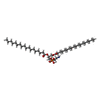 ChemComp-3PE: 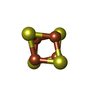 ChemComp-SF4: 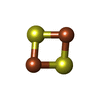 ChemComp-FES:  ChemComp-FMN: 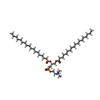 ChemComp-PC1: 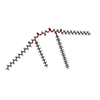 ChemComp-CDL:  ChemComp-ADP: 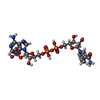 ChemComp-NDP:  ChemComp-ZN:  ChemComp-EHZ:  ChemComp-ACE: |
| 由来 |
|
 キーワード キーワード | OXIDOREDUCTASE / Complex I / mitochondria / proton pump / membrane protein |
 ムービー
ムービー コントローラー
コントローラー 構造ビューア
構造ビューア 万見文献について
万見文献について








